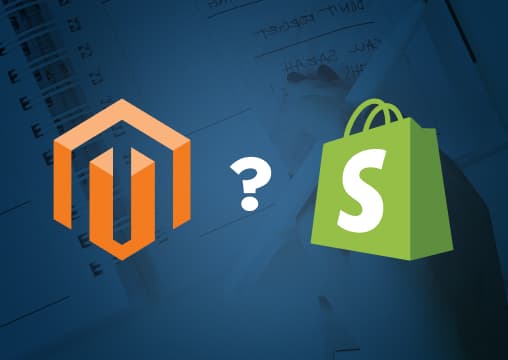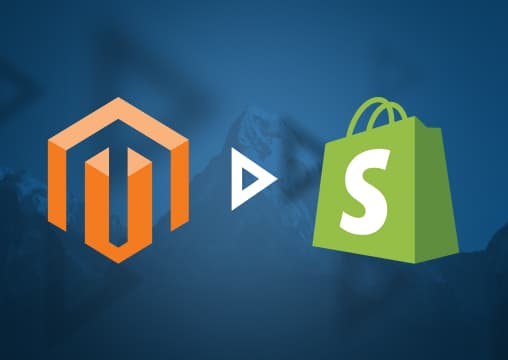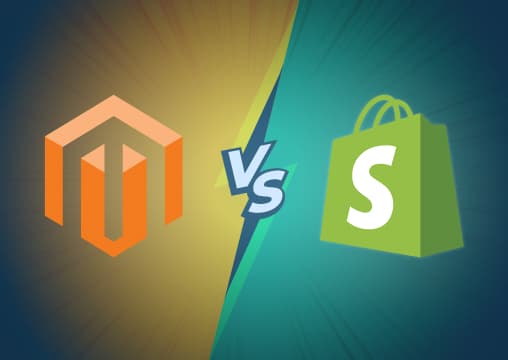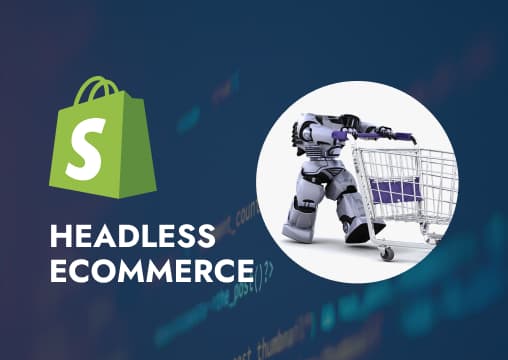
Shopify vs Shopify plus
By 2022, Shopify Inc. had become one of the leading service providers in the online shopping space. As of this writing, it currently has:
- 25% market share.
- Over 2.6 million users in the United States of America.
- Availability in over 170 countries.
- Two different solutions catering to two different audiences.
Yes, Shopify Inc. owns Shopify as well as Shopify Plus — but the usability, differences, features, and pricing of these two solutions often confuses users.
The most important question they’re left asking in this “Shopify vs Shopify Plus” debate is which solution is the best for them and their business.
So, let’s take a look to understand what is the difference between Shopify and Shopify Plus, what are their highlighted features, and which solution is going to be an ideal choice for your business.
What exactly is Shopify Plus?
Shopify Plus is the premium version of Shopify that’s targeted toward more enterprise-level customers. Shopify Plus can handle over three million visitors per second, 10,978 orders in a minute, and has a 99.99% uptime.
The solution can also be customized to over 20 languages and is available in more than 175 countries, so users and customers from all parts of the world can use it without running into any issues.
Shopify Plus also allows its users to create over ten stores, which in turn helps them manage their many businesses using just one solution. Oh, and did we mention you can also add an almost unlimited amount of integrations and customize the solution using popular web development languages?
Users in fashion, home furnishing, food, beauty, apparel, consumer electronics, and cosmetics industries use Shopify Plus quite often. In fact, popular websites like StyleCraze, SpaceX, Sophos, Sega, Touchland, Hero Cosmetics, and more are currently hosted on Shopify Plus.
Since Shopify Plus is a cloud-based solution, it also becomes easier to set-up and access everything there, and do so without causing any downtime. So, if you’re interested in an enterprise solution and want to process orders faster, then you should definitely consider Shopify Plus as your answer (most users do, considering that Shopify ranks as the “#2 solution” in the top online shopping service providers).
Difference between Shopify and Shopify Plus
While Shopify and Shopify Plus are both created by the same company, the number of overall features, pricing, the user experience, and customer support options vary greatly. And this is mainly because both are geared toward two different audience types — Shopify is for small and medium businesses, and Shopify Plus is for extremely large enterprise-level businesses that see more website visitors.
But that’s not where the differences stop. So, let’s have a Shopify and Shopify Plus comparison.
Alright, let’s consider user support first (which is one category that Shopify has always been a winner in). Shopify users get support through Shopify Experts who are ready to help them with their issues, whenever any arise. Shopify Plus, on the other hand, has a dedicated account manager and a launch engineer manager who are ready to guide users through all possible challenges that may emerge on Shopify Plus.
Shopify Plus users also get to access a few premium apps that Shopify users might not otherwise get their hands on — for example, the former has Shopify Flow, Shopify Script, Launchpad, Transporter, Bulk Account Inviter, and premium API resources (like gift cards, flash sales, custom discounts, different passes for website and store visitor, and being able to edit user information).
Furthermore, Shopify Plus also provides wholesale channels that can look and feel the same as any retail store on the platform.
And, as we mentioned above, users on Shopify Plus can also access its stores in 20+ languages, conduct business in multiple currencies, and do so in nearly 200 countries. Clients of the service provider also get to have unlimited staff accounts — which is ideal if you have a large team spread across the world.
That’s not all we have on the Shopify vs Shopify Plus debate. To learn which solution is the right fit for you and your team, let’s take a look at the highlighted Shopify and Shopify Plus features and compare these solutions based on their pricing.
Shopify inventory management features
Inventory tracking is one of the most important aspects of any business. So, what options does Shopify offer for inventory management, you ask? Let’s take a look.
- Track individual inventories. Admin can change the inventory field manually, and can also categorize orders based on multiple categories such as size, type, season, etc.
- Update inventories. Users can also update the quantities of inventory in a systematic way (which is an especially useful feature when dealing with bulk orders).
- View archives and version history. People with a Shopify solution can also view the information of inventory, such as quantity level, date of consignment, changes made, updates made, etc.
- Manage stocks. Users can manage and track their inventory based on multiple categories, such as weight, size, inventory number, pricing, SKU, colors, supplier name, etc.
Shopify also sends its users inventory reports which allow them to analyze their products (this report is usually generated at the end of the month).
Shopify’s reasonable payment processing fees
If there’s one thing all Shopify partners love about the platform is that it has 0% payment processing fees (meaning: when you purchase a plan with Shopify, that’s the only thing you pay for — they won’t ask you to shell out extra bucks when setting up a checkout page). So, all in all, Shopify payment fees are capped at $0.
However, if users wish to add third-payment payment platforms to their stores (as would be necessary in most cases), Shopify still charges a minimal fee for the integration. For context, the fee is 1% of the total order value on the “Shopify” plan, 2% of the total order value on the “Basic” plan, and 0.5% of the total order value on the “Advanced” plan.
Please note: a fee of 2.9% for credit card transactions (plus 30 cents) would be applied per transaction with the Basic plan. The same is true for both the Shopify and Advanced plans, too — they have a rate of 2.6% plus 30 cents per transaction and 2.4% plus 30 cents per transaction, respectively.
Shopify multiple user accounts
People operating a store might not be able to address all tasks alone — they would most likely need to collaborate with their staff members on the platform or have them take over some operations. Shopify understands this, which is why it allows users to add staff accounts to the store (and it even gives the admin the authority to restrict certain permissions).
For the Basic plan, Shopify allows up to two staff accounts and four inventory locations. For the Shopify plan, users are allowed up to five staff accounts and five inventory locations. And for the Advanced plan, Shopify allows up to 15 staff accounts and up to 8 inventory locations. If users wish to add more accounts, then they might need to switch to Shopify Plus instead.
To see which version works best for you, we recommend you opt for the free trial to see how fruitful you find these Shopify plans.
Shopify Plus omnichannel sales features
Omnichannel eCommerce is a strategy that sees the maximum amount of customer retention, so it’s no wonder that Shopify Plus has done all it can to make its omnichannel sales features legendary. At the present moment, Shopify Plus has a POS (point of sale) app that allows users to have a seamless omnichannel experience.
For example, they can pick up orders in-person, even if they have placed the order in the online store, have products shipped to them directly, browse products in-store and then set up orders online, or exchange or return shipped orders (either in-store or online).
To go one step further, Shopify Plus users can also manage the permissions of retail staff, create loyalty programs, publish a never-ending catalog, sync customer profiles using all platforms, manage inventory, and get unified reports on growing trends (trends are derived by combining in-store and online data.)
Shopify Plus also allows users to track customer journeys using “Attribution Connector,” which helps them understand how to improve their processes.
Additionally, Shopify Plus users can access their platform in various countries, work with over 100+ global payment providers, create faster checkout experiences by 60%, etc., thereby getting to experience a whole new level of user accessibility.
Shopify Plus — better features for larger operations
Shopify Plus allows users to manage, sell, and integrate their business — thereby creating a 360-degree solution for all possible requirements of any online store. The platform also helps users migrate from both legacy systems and other systems in less than 90 days. And it’s been so successful in providing these world-class features that it has converted names like Staples, Heinz, Mongolia, Steve Madden, All Birds, Rebecca Minkoff, and more.
Let’s drill down on what you can do with Shopify Plus’s features:
1. Manage automation, shipping, and payment
Shopify Plus prides itself on being able to handle any kind of workflow, capability, or complexity. The platform facilitates solutions that help users make more than one billion automated decisions every month.
Aside from this, users can also manage orders with the help of Shopify’s actionable insights (that are based on recent data), unlimited user support, and accurate order levels.
And as far as payments are concerned, users can rely on over 100+ global payment providers (and protect transactions with 3D Secure, data encryption, bot protection, and more).
2. Set up an online, international, and/or eCommerce store
To ensure that its users can expand and promote their products to their audiences the right way, Shopify Plus allows them to set up online, international, and/or eCommerce stores, which help business owners access customers from any part of the world and create seamless experiences in such a way that it results in more conversions.
Shopify has been highly successful, too. For context, by providing such a seamless experience, it’s seen more than 2.5 billion orders being placed and more than 300 million customers using Shopify Checkout. Shopify can also provide users with customizable languages, currencies, domains, storefronts, taxes, and pricing so that their sites are highly optimized for use in every country.
3. Do business B2B or B2C
While most users know Shopify Plus for its B2C capabilities, it also provides solutions for the B2B audience — so DTC and wholesale operators, you can now rejoice!
With their B2B products, users can now create company profiles, price lists, payment terms, customer accounts, self-serve portal, and can also integrate tools and get access to insights on customers.
The platform also allows users to do headless commerce, manage campaigns and flash sales, provides in-depth user analytic reports, and allows users to integrate systems, automations, and partners.
Shopify vs Shopify Plus pricing
At the present moment, Shopify offers three different pricing options: Basic, Shopify (also known as Standard), and Advanced. The Basic plan is available for $29/month, the Standard plan is available for $79/month, and the Advanced plan is available for $299/month. Users can save around 10% if they opt for the yearly membership.
As far as Shopify Plus prices are concerned, they depend on the amount of revenue you generate. For example, they begin at $2000/month for customers who generate revenue between $0 – $800,000. For users who generate around a million dollars in revenue, the pricing is capped at $2500/month. In the same way, customers who earn five million dollars pay $12,500/month; those who bring in 12 million dollars pay $30,000/month; and those that make upwards of 16 million end up paying around $40,000/month.
We already know how much Shopify charges for credit card payments and how much it is per transaction fee. Shopify Plus charges are 1.6% plus 35 cents if you use the Shopify platform for payment processing, but if you use a third-party payment provider, you’ll end up shelling out the same amount plus another 0.15% per transaction.
Please note: The Shopify vs Shopify Plus pricing mentioned here was jotted down during the time of writing the article — the prices may change at any time (but we’ll do our best to update them!).
Conclusion: Shopify and Shopify Plus Comparison
So, where does all this land us in the grand scheme of the Shopify vs Shopify Plus debate? Well, it depends on the kind of business you operate. For example, if you have a small or medium business, we recommend you opt for Shopify.
But if your business generates more revenue, has a larger pool of customers, requires more staff to manage it, and more support from your service provider, then Shopify Plus is the solution for you.
And, if you need any help setting up either of these accounts to ensure that they’re future-proofed and ready to take on any challenge, then get in touch with MTN Haus — we can lend you our expertise!




